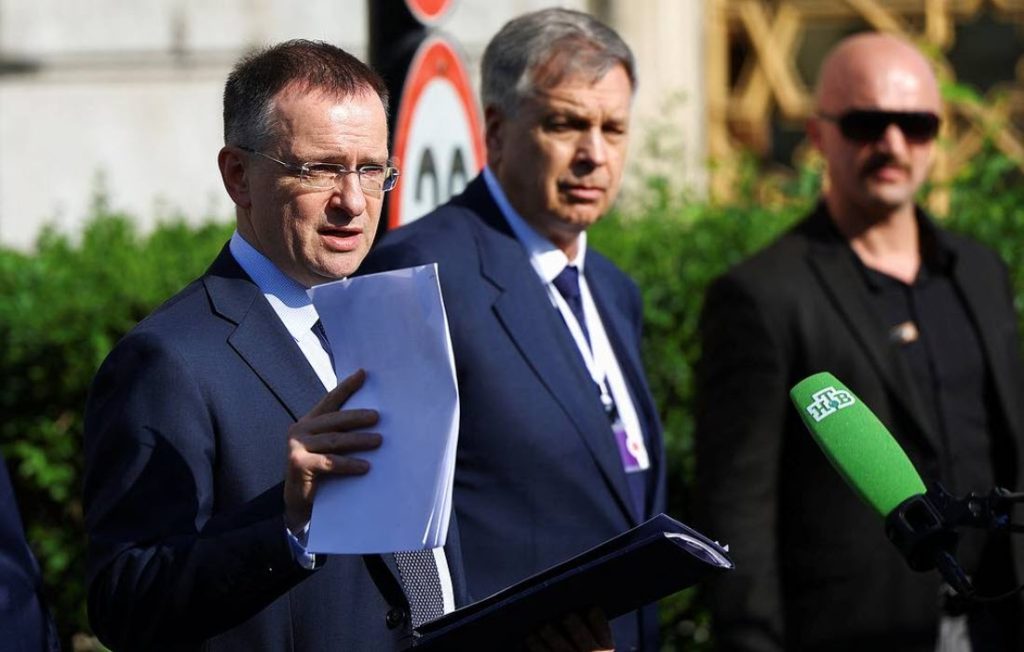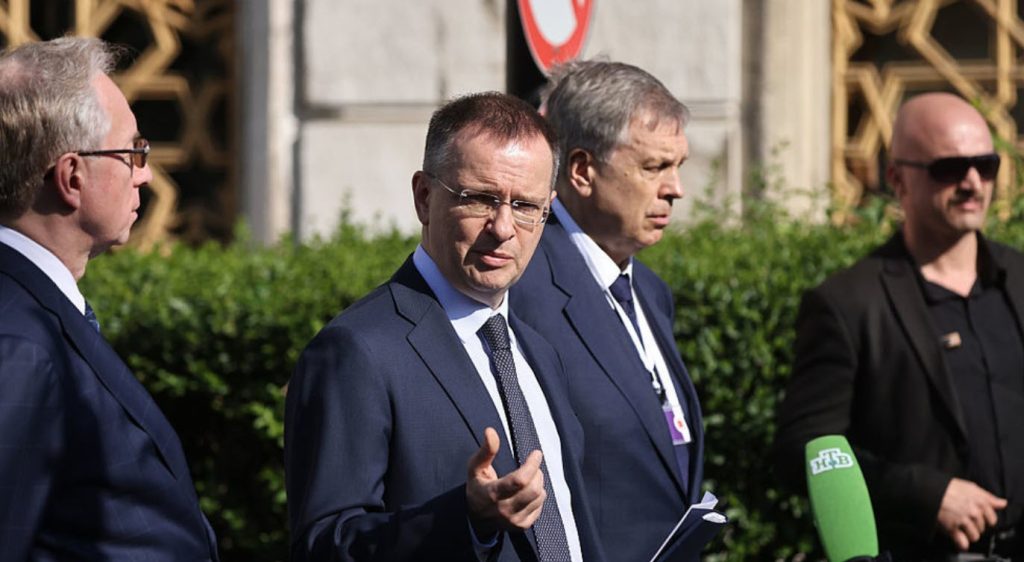What Russia and Ukraine Agreed in 2nd Round of Istanbul Talks
by Sputnik [6-2-2025 published].
Russian delegation head Vladimir Medinsky, an aide to Russian President Vladimir Putin, reported the key outcomes of the negotiations with Ukrainian representatives in Istanbul.
Key statements:
- Russia handed Ukraine a draft memorandum on settlement, which Kiev took for study
- The Russian settlement memorandum is in two parts and is detailed and well-developed
- The first part focuses on how to achieve genuine long-term peace
- The second part outlines steps for a full ceasefire, allowing for flexibility and multiple paths to that goal
- Russia will unilaterally transfer 6,000 bodies of Ukrainian soldiers to Kiev next week, having identified all the deceased
- The parties agreed on the largest-yet prisoner exchange
- The total exchange will be at least 1,000 prisoners, possibly more
- Sick and seriously wounded prisoners will be exchanged on an "all for all" basis
- Moscow and Kiev will create a commission to exchange seriously wounded troops without political decisions
- The sides will exchange soldiers under the age of 25
- Russia offered Ukraine a concrete ceasefire for two to three days in certain frontline sectors
- Moscow and Kiev agreed to a ceasefire in specific areas so commanders can retrieve the bodies of their soldiers
- The Ukrainian armed forces promised to work out the ceasefire proposal for those areas soon
- Kiev turned the issue of 'child abductions' into a 'show for sentimental Europeans'
- No children have been kidnapped by Moscow, only rescued by Russian soldiers
- Russia received a list of 339 children from Ukraine who are in difficult situations due to the conflict
- Moscow returns children to Kiev if their parents or legal guardians are present
- Russia is working on reuniting families separated by the Ukraine conflict
- The negotiations with Ukraine were conducted in Russian
The Russian delegation was satisfied with the results of the second round of talks with Ukraine, Medinsky said.
Ukraine's neutrality, recognition of Donbass, Novorossiya: key ideas of Russian memorandum

by TASS [6-2-2025 published].
The first section of the document contains the "basic parameters of the final settlement", the second section of the document, devoted to the terms of the ceasefire, contains two scenarios the events might follow.
MOSCOW, June 2. /TASS/. The Russian memorandum on a future settlement, handed over to the Ukrainian delegation at the negotiations in Istanbul, implies Ukraine's neutrality and a ban on any military activity by third countries on its territory. Russia's proposals, set out in the document obtained by TASS, envisage elections in Ukraine, followed by the signing of a peace treaty.
The first section of the document contains the "basic parameters of the final settlement." The second section of the document, devoted to the terms of the ceasefire, contains two scenarios the events might follow. And the third section establishes the sequence of steps and the deadlines for their implementation.
TASS has reviewed the main provisions of the memorandum.
Terms of settlement
- As part of the ceasefire option, Kiev is offered to sign an agreement to implement the provisions for a final settlement.
- The document implies international recognition of Crimea, Donbass, and Novorossiya as part of Russia.
- For a final settlement in Ukraine, it is crucial to ensure the full rights, freedoms, and interests of Russian speakers.
- This includes granting Russian the status of an official language and a legislative ban on the glorification and propaganda of Nazism and neo-Nazism.
- Also, for a settlement in Ukraine, it is necessary to remove all restrictions on the Ukrainian Orthodox Church.
- The memorandum implies Ukraine's neutrality, which means its pledge not to join military alliances and coalitions, a ban on any military activity by third countries on the territory of Ukraine, and on the deployment of foreign military forces, military bases, and military infrastructure there.
- There is a direct ban on the acceptance, transit, and deployment of nuclear weapons in Ukraine.
- The document provides for the establishment of caps on the strength of the armed forces, weapons, and military equipment.
- It provides for the lifting of all existing sanctions by Ukraine against Russia and the mandatory pledge not to impose new ones.
- The document implies the waiver of mutual claims with Ukraine in connection with damage caused by hostilities.
- The document provides for the phased restoration of diplomatic and economic relations with Ukraine, including gas transit.
Conditions for a ceasefire
- One ceasefire option for Kiev is the complete withdrawal of the Ukrainian army from the DPR, LPR, and the Kherson, and Zaporozhye Regions.
- From the moment the Ukrainian military begins to withdraw from the territory of Russia, including Donbas and Novorossiya, a 30-day ceasefire will be established.
- The withdrawal must be completed within 30 days of the ceasefire.
- The other option for a ceasefire for Kiev involves a package of 10 points.
- A ceasefire in Ukraine, in particular, implies a ban on the redeployment of the Ukrainian armed forces, with the exception of movements for withdrawal to an agreed distance from the borders of Russia.
- For the ceasefire, all Western arms supplies to Ukraine shall be halted; the same applies to the provision of intelligence data.
- The military presence of third countries on the territory of Ukraine must be excluded, and the participation of foreign specialists in military operations on the side of Ukraine must be stopped.
- The ceasefire in Ukraine implies the cancellation of martial law by Kiev.
- A bilateral center for monitoring and controlling the ceasefire is to be established.
- In addition, mobilization is to be halted and demobilization begun in Ukraine in order to achieve a ceasefire.
- Furthermore, the document calls for the dissolution of nationalist formations in Ukraine.
- Kiev must grant amnesty to political prisoners and release detained military personnel and civilians.
Terms and procedure for signing the peace treaty
- In the third section of the document, which establishes the sequence of steps and the deadlines for their implementation, immediately after Russia transfers 6,000 bodies of deceased military personnel to Ukraine, there will be "the signing of a memorandum on a ceasefire with specific dates for the implementation of all its provisions and the determination of the date for the signing of a future treaty on a final settlement.
- That done, a 30-day ceasefire is to be established.
- Next comes "the holding of elections, the formation of authorities on the territory of Ukraine," followed by "the signing of the treaty."
- The Ukrainian authorities must announce the date of the presidential and parliamentary elections, due to take place no later than 100 days after the lifting of martial law.
- The peace treaty between Russia and Ukraine shall be approved by a legally binding resolution of the UN Security Council.
Russian memorandum on settlement of Ukraine conflict (FULL TEXT)

Head of the Russian delegation Vladimir Medinsky speaks to the media after the second round of Ukraine-Russia peace talks on June 2, 2025 in Istanbul, Turkey. © Burak Kara / Getty Images
by RT [6-2-2025 published].
Moscow handed over the document to Kiev during the second round of talks in Istanbul.
The Russian delegation presented its peace proposal to the Ukrainian side during the talks in Istanbul on Monday.
Among the main points, Moscow’s memorandum calls on Kiev to withdraw its troops from the former Ukrainian territories that have joined Russia and confirm its neutral and non-nuclear status.
Draft as of June 1, 2025
Proposals of the Russian Federation (Memorandum) on the Settlement of the Ukrainian Crisis
Section I
Key Parameters for a Definitive Settlement
- International legal recognition of the incorporation into the Russian Federation of Crimea, the LPR, the DPR, and the Zaporozhye and Kherson regions; full withdrawal from these territories of Armed Forces of Ukraine (AFU) units and other Ukrainian paramilitary formations;
- Neutrality of Ukraine, implying its refusal to join military alliances and coalitions, as well as a ban on any military activity by third-party states on Ukrainian territory and the deployment of foreign armed formations, military bases and military infrastructure there;
- Termination of all existing international treaties and agreements inconsistent with the provisions of Paragraph 2 of this Section, and refusal to conclude any such agreements in the future;
- Confirmation of Ukraine’s status as a state without nuclear or other weapons of mass destruction, with a direct ban on their receipt, transit and deployment on Ukrainian territory;
- Establishment of maximum limits for the size of the AFU and other Ukrainian military formations, the quantity of armaments and military equipment, and their permissible specifications; dissolution of Ukrainian nationalist formations within the AFU and National Guard;
- Guarantees of the full rights, freedoms and interests of the Russian and Russian-speaking population; granting the Russian language official status;
- Legislative prohibition of the glorification and propaganda of Nazism and neo-Nazism, dissolution of nationalist organizations and parties;
- Lifting of all current economic sanctions, bans and restrictive measures between the Russian Federation and Ukraine, and refusal to impose new ones;
- Resolution of issues related to family reunification and displaced persons;
- Waiver of mutual claims for damages incurred during hostilities;
- Removal of restrictions imposed on the Orthodox Church of Ukraine;
- Gradual restoration of diplomatic and economic relations (including gas transit), transport and other connections, including with third-party states.
Section II
Ceasefire Conditions
Option 1.
Commencement of complete withdrawal of the AFU and other Ukrainian paramilitary formations from the territory of the Russian Federation, including the DPR, LPR, and the Zaporozhye and Kherson regions, and their pullback from the borders of the Russian Federation to a distance agreed upon by the Parties, in accordance with Provisions to be approved.
Option 2. “Package Proposal”:
- Prohibition on redeployment of the AFU and other Ukrainian paramilitary formations, except for movements aimed at withdrawal from the borders of the Russian Federation to a distance agreed upon by the Parties;
- Cessation of mobilization and commencement of demobilization;
- Cessation of foreign supplies of military products and foreign military assistance to Ukraine, including the provision of satellite communication services and intelligence data;
- Elimination of military presence of third countries on Ukrainian territory, cessation of participation of foreign specialists in military operations on Ukraine’s side;
- Guarantees of Ukraine’s renunciation of sabotage and subversive activities against the Russian Federation and its citizens;
- Establishment of a bilateral Center for Monitoring and Control of the Ceasefire Regime;
- Mutual amnesty for “political prisoners” and release of detained civilians;
- Lifting of martial law in Ukraine;
- Announcement of the date for elections of the President of Ukraine and the Verkhovna Rada, which must take place no later than 100 days after the lifting of martial law;
- Signing of an Agreement on the implementation of provisions contained in Section I.
Section III
Sequence of Steps and Timeline for Implementation
- Work commences on drafting the Treaty text;
- A 2-3 day ceasefire is declared for collection of bodies of the fallen in the “gray zone”;
- Six thousand bodies of AFU servicemen are unilaterally transferred to the AFU;
- A Ceasefire Memorandum is signed with specific dates for fulfillment of all provisions, determining the date for signing the future Treaty on Final Settlement (hereinafter, the Treaty);
- A 30-day ceasefire regime takes effect from the moment the AFU withdrawal begins. Complete withdrawal of AFU units from the territory of the Russian Federation and full implementation of the “package agreement” must be completed within these 30 days;
- Elections are conducted and government bodies are formed on the territory of Ukraine;
- The Treaty is signed;
- The signed Treaty is endorsed by a legally binding UN Security Council resolution;
- The Treaty is ratified, enforced, and implemented.